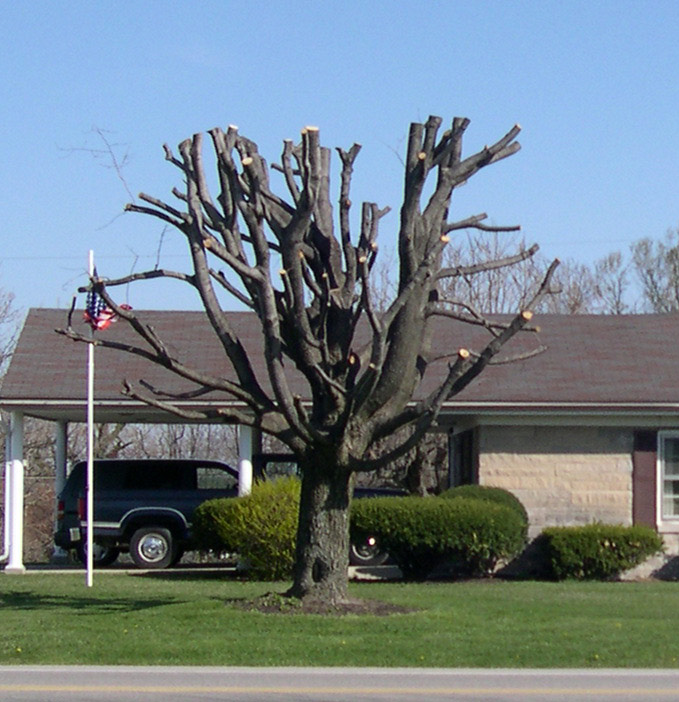
Topping Trees is Not the Answer
It still shocks me when I see large trees being “trimmed” or “topped” in this day and age. Topping is the drastic removal or cutting back of large branches in mature trees, leaving large stubs. The result is so ugly and cruel, and the process so expensive, I have a hard time imagining why anyone would want to do that to a tree.
Homeowners often call for tree topping, perhaps because they view large trees as dangerous. This practice was once thought to be a good way to prevent large limbs from breaking off and falling, or to reduce the height of trees considered too large for a particular site. In fact, topping makes it more likely that limbs will break off, and a topped tree will re-grow to its original height faster than a tree that has received proper pruning.
I understand that large, mature trees can interfere with utility lines, block important views, grow too close to buildings or crowd neighboring trees. Trees are often planted without considering their final mature size, so utility companies frequently top trees to protect overhead wires. Tree “trimmers” aren’t trained arborists skilled at selective pruning, so they often do more harm than good.
Topped trees grow vigorous “water sprouts” just below the pruning wound. These rapidly growing shoots have very weak attachment to the remaining stub, making them vulnerable to wind and ice damage. They are much more weakly attached than the original limb, and so much more likely to break off and fall.
Topping injures trees in many ways. Large branch stubs that result from topping invite insects and wood-rotting pathogens, which find the living but defenseless stub an inviting and plentiful source of food. Stubs can’t wall-off or heal over the wound or protect themselves. Once decay has entered the branch stub, it progresses into the main trunk, hollowing out and eventually killing the tree.
Bark suddenly exposed to the sun after topping often is damaged by sunscald, and may become diseased, further weakening the tree. Removing a major portion of the canopy upsets the delicate balance between foliage and the rest of the tree. Large reserves of stored energy in many stems and branches also are lost when trees are topped. Sprouts resulting from topping are very succulent and more susceptible to attack from insects and diseases, particularly fire blight.
There’s a slippery slope of expense involved once a tree is topped for the first time, a step which costs hundreds of dollars. It’s just a matter of time until the tree re-grows, this time with weakly attached water sprouts, and will need topping again. Eventually the whole tree will have to be removed. Because the results often are short-lived, topping is a more costly solution to the problem of interfering trees than selective thinning or pruning. Topping disfigures the tree and ruins its beauty, replacing its natural form with unsightly branch stubs, ugly pruning wounds and a “witch’s broom” of branch re-growth.
The real solution to this problem is to select trees that fit the space. There are trees available that will grow to every shape and size imaginable, from dwarf ornamentals to huge towering shade trees, from narrow columnar forms to wide spreading canopies. The first step in selecting which tree to plant is to figure out how tall and wide it can get before outgrowing the space where you’re planning to plant it.
Steve Boehme and his wife Marjorie own GoodSeed Farm Landscapes, a design-build landscape/hardscape installer specializing in outdoor living spaces. More information is available at www.goodseedfarm.com or call GoodSeed Farm & Garden at (937) 695-0350.

